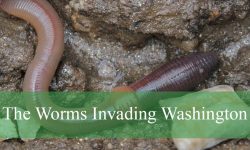South Florida’s tropical paradise—famous for its sunshine, beaches, and palm trees—has a hidden problem lurking in its backyards and canals. It’s not hurricanes or snakes this time, but something smaller, faster, and surprisingly bold: invasive lizards.
From iguanas sunbathing on seawalls to bright green anoles darting across driveways, these reptiles are now everywhere. Once exotic pets or accidental stowaways, invasive lizards have established massive populations across the region. They climb trees, dig burrows, devour native plants, and even damage infrastructure.
In this detailed exploration, we’ll uncover the strange invasive lizards taking over South Florida—where they come from, why they thrive, and what makes them one of the state’s most bizarre ecological challenges. By the end, you’ll understand how these scaly invaders are transforming Florida’s ecosystems—and why removing them is harder than it seems.
The Lizard Invasion Begins
A Reptile Paradise
Florida’s warm climate, abundant vegetation, and year-round humidity make it a perfect home for reptiles. Unfortunately, these same conditions also attract non-native species that escape captivity or hitchhike on imported goods.
Over 60 species of lizards now live in Florida—more than anywhere else in the continental U.S.—and the majority are not native. In fact, experts estimate that over 80% of Florida’s lizard species are invasive.
How They Arrived
Most invasive lizards in South Florida came through three main routes:
- Pet trade – Many exotic reptiles were imported as pets, only to escape or be released when they grew too large or aggressive.
- Cargo shipments – Lizards often sneak into crates of tropical plants or building materials arriving from Central and South America or Asia.
- Storm displacement – Hurricanes sometimes release captive populations into the wild, giving them a head start on establishing colonies.
Once free, these adaptable lizards quickly found everything they needed—heat, food, and no natural predators.
The Most Common Invasive Lizards in South Florida
1. Green Iguana (Iguana iguana)
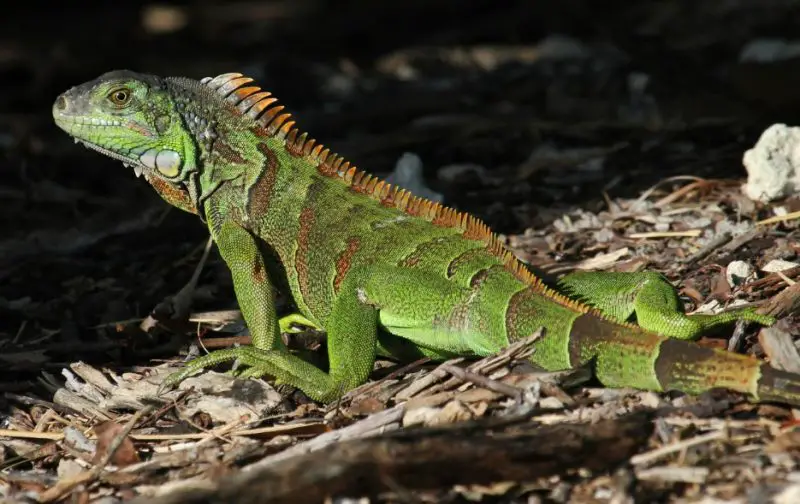
The green iguana is the most visible—and destructive—of all invasive lizards in Florida. Originally from Central and South America, it can grow up to 5 feet long and weigh over 15 pounds.
These lizards love urban areas. They bask on rooftops, canals, and seawalls, and burrow into embankments. Their tunnels can weaken roads, sidewalks, and foundations, causing millions in property damage annually.
Iguanas feed on ornamental plants, fruits, and vegetables. In coastal cities like Miami and Fort Lauderdale, they raid gardens and defecate in swimming pools. Despite their docile appearance, male iguanas can become territorial during mating season.
2. Brown Anole (Anolis sagrei)
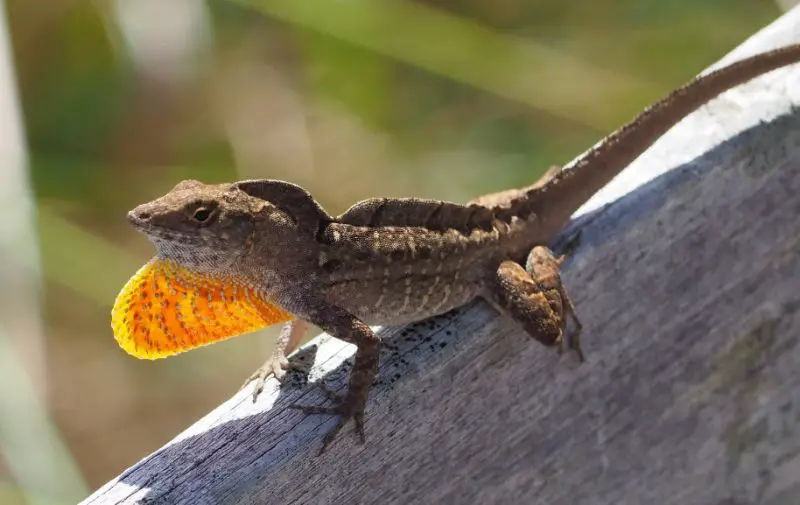
Once native to Cuba and the Bahamas, the brown anole is now one of Florida’s most abundant reptiles. These small, quick lizards outcompete native green anoles for territory and food.
Brown anoles thrive in parking lots, sidewalks, and suburban yards. Their adaptability and aggressive nature allow them to dominate nearly every environment they enter.
3. Knight Anole (Anolis equestris)
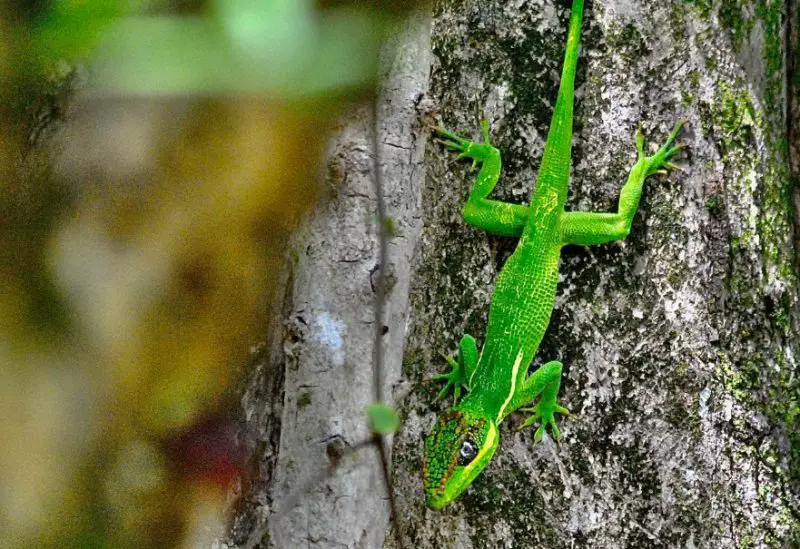
Originally from Cuba, the knight anole is Florida’s largest anole, reaching up to 18 inches long. Its bright green color and yellow dewlap make it easy to spot in trees.
Unlike smaller anoles, knight anoles are capable predators—they eat frogs, smaller lizards, and even small birds. They are most common in Miami-Dade and Broward Counties, where they’ve adapted perfectly to urban and suburban habitats.
4. Nile Monitor (Varanus niloticus)
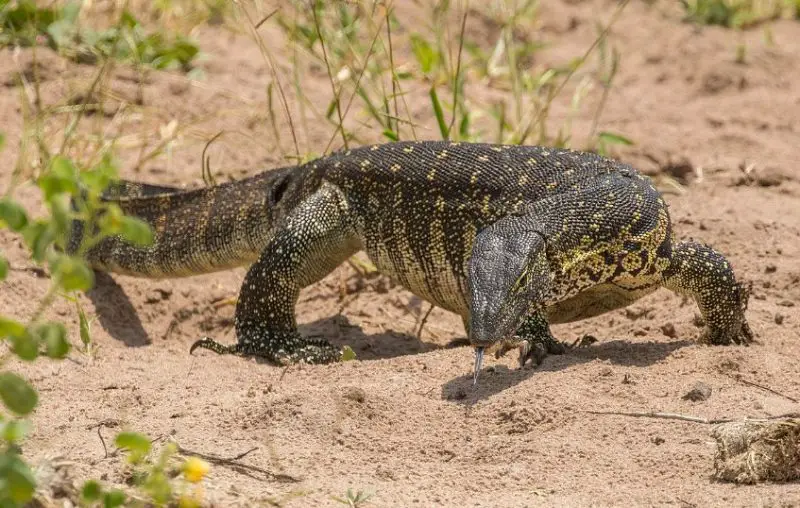
The Nile monitor is one of the most alarming invaders. Native to Africa, this species can exceed 7 feet in length and is an apex predator.
They are strong swimmers, excellent climbers, and highly intelligent hunters. Nile monitors feed on anything from birds and fish to eggs of endangered species like sea turtles. Populations have been reported in Palm Beach, Lee, and Miami-Dade counties, and they pose serious threats to native wildlife.
5. Argentine Black and White Tegu (Salvator merianae)
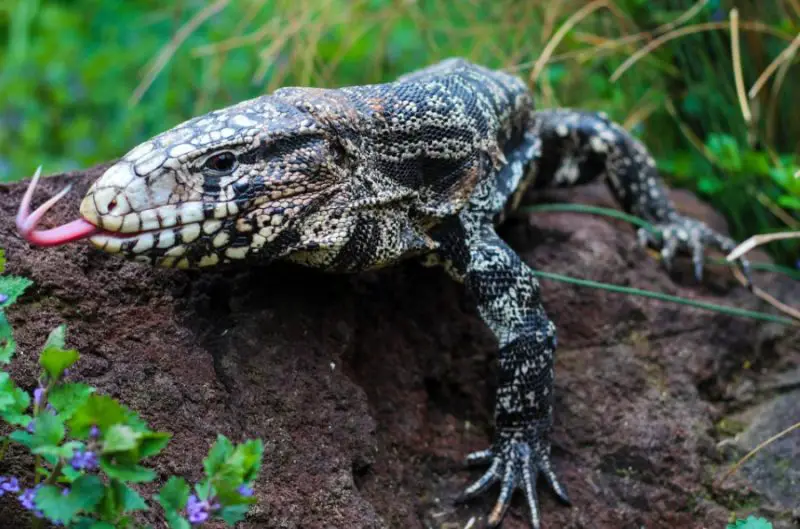
The Argentine tegu has become one of Florida’s most problematic invasive reptiles. It can grow to 4 feet long, with powerful jaws and a voracious appetite.
Tegus eat bird eggs, reptiles, small mammals, and fruit. They are particularly destructive in areas where ground-nesting species live, such as the Everglades. Their high reproduction rate and ability to survive cold winters make them especially difficult to control.
Why Invasive Lizards Thrive in South Florida
Perfect Climate
South Florida’s subtropical climate mirrors that of their native habitats in Central and South America. Mild winters mean that even tropical lizards can survive year-round.
Abundant Food
From insects and plants to pet food left outdoors, the region offers endless food sources. Urban areas provide shelter in gardens, walls, and sewer systems.
Few Natural Predators
Native predators like hawks or snakes are not enough to control fast-breeding lizards. Many invasive species are too large, aggressive, or well-camouflaged to be hunted effectively.
Human Habitats
Cities provide the perfect artificial ecosystem: heat-reflecting concrete, irrigated lawns, and plenty of hiding spots. Lizards thrive where people do, making human environments ideal for their expansion.
Ecological Impact of the Lizard Takeover
1. Competition with Native Species
Invasive lizards often outcompete native species like the green anole and Florida scrub lizard for food and territory. This competition pushes native populations into smaller, fragmented habitats.
2. Predation on Native Wildlife
Large lizards such as tegus and monitors prey on native birds, frogs, and reptiles. They eat the eggs of ground-nesting species, including endangered sea turtles and alligators.
3. Agricultural and Property Damage
Iguanas and tegus cause millions of dollars in agricultural losses annually. They feed on fruits, vegetables, and ornamental plants, while their burrows destabilize infrastructure like seawalls and canals.
4. Disease Transmission
Some invasive reptiles carry parasites and bacteria, including Salmonella, which can spread to humans and pets through contact with droppings or contaminated water.
Human-Lizard Conflicts
Iguanas in Urban Areas
In South Florida, it’s common to see iguanas blocking sidewalks, falling from trees during cold snaps, or basking beside pools. During extreme cold, iguanas enter a temporary paralysis, causing them to drop from branches—a phenomenon locals now call “frozen iguana season.”
Tegus and Monitors in Rural Zones
Rural residents encounter tegus raiding chicken coops or burrowing near homes. Nile monitors, in particular, are known to invade canal systems and prey on native fish and birds, causing concern among residents and conservationists alike.
Government and Conservation Response
Statewide Efforts
The Florida Fish and Wildlife Conservation Commission (FWC) leads the effort to control invasive reptiles. Programs include:
- Trapping and removal operations in key habitats.
- Public reporting hotlines for lizard sightings.
- Permits and bans on importing or breeding high-risk species.
Professional Removal Teams
Licensed trappers capture iguanas, tegus, and monitors for humane euthanasia or relocation. Iguana control has even become a small industry, with removal companies offering services to homeowners and businesses.
Public Education
FWC and environmental groups run awareness campaigns urging pet owners not to release exotic reptiles into the wild. They also promote “Don’t Let It Loose”, a program aimed at responsible pet ownership and reporting abandoned reptiles.
Myths and Misconceptions
Myth |
Truth |
|---|---|
Invasive lizards eat humans or pets. |
False. Most species are harmless and avoid confrontation. |
They only live in swamps. |
False. Many species thrive in cities, parks, and neighborhoods. |
Cold weather will eliminate them. |
Not true. Some species survive freezes by burrowing underground. |
Killing them is illegal. |
False. In Florida, property owners can humanely remove invasive lizards year-round. |
They only came from pet stores. |
Many arrived accidentally through cargo shipments. |
Strange and Fascinating Facts About Florida’s Lizards
- Iguanas can regrow their tails after losing them to predators.
- Tegus can run on their hind legs when threatened, like miniature dinosaurs.
- Knight anoles hiss and gape their mouths when defending territory.
- Nile monitors can stay underwater for up to 30 minutes.
- Brown anoles display dominance with push-up motions and head bobs.
- Iguanas can fall 40 feet without injury, using their tails to break the fall.
- Some lizards eat poisonous plants with no ill effects.
- Female tegus can reproduce without males through a rare process called parthenogenesis.
The Future of Florida’s Lizard Crisis
Growing Populations
Despite control efforts, populations of iguanas, tegus, and anoles continue to expand. Warm winters and high reproduction rates make eradication nearly impossible.
Climate Change Advantage
As temperatures rise, more tropical species could invade and survive farther north in Florida. Experts warn that new invasive reptiles could appear within the next decade.
Potential Solutions
- Community-based monitoring: Residents reporting sightings.
- Research on biological control: Studying potential predators or diseases.
- Public education: Preventing pet release and supporting removal programs.
While eradication may be unrealistic, containment and management remain achievable goals with public cooperation.
FAQs About Invasive Lizards in South Florida
Are invasive lizards dangerous?
Most are not. They may bite if handled, but they prefer to flee. Large species like monitors can inflict serious wounds if provoked.
Can I remove them from my property?
Yes. In Florida, property owners can humanely kill or remove invasive reptiles without permits.
Why are iguanas everywhere?
They reproduce rapidly, lack predators, and thrive in the warm, urban landscape.
What should I do if I see a tegu or monitor?
Report it immediately to the FWC Exotic Species Hotline and avoid handling it.
Do these lizards affect native wildlife?
Yes. They compete for food and prey on native animals, causing biodiversity loss.
Conclusion
The invasive lizards of South Florida are a vivid reminder of how quickly nature adapts when humans disrupt ecosystems. These strange reptiles—from massive iguanas to stealthy tegus—represent both the beauty and the fragility of Florida’s wild landscapes.
Their story is not one of villains, but of imbalance—an unintended consequence of global trade, curiosity, and climate change. Managing them requires understanding, cooperation, and respect for the interconnected web of life that defines Florida’s wetlands, suburbs, and backyards.
So the next time you see a bright green shape scurrying across your fence or basking under the Florida sun, remember: it’s not just another lizard—it’s part of a much larger, stranger story unfolding in the Sunshine State.


